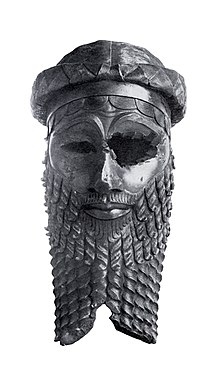| Revision as of 16:03, 24 June 2007 editAndrew c (talk | contribs)Extended confirmed users31,890 editsm →References: +cats← Previous edit | Revision as of 06:47, 29 June 2007 edit undoDbachmann (talk | contribs)227,714 edits →Akkadian PeriodNext edit → | ||
| Line 4: | Line 4: | ||
| ==Akkadian Period== | ==Akkadian Period== | ||
| {{main|Akkadian Empire}} | |||
| ], the founder of the Akkad dynasty.]] | ], the founder of the Akkad dynasty.]] | ||
| The Assyrian roots go back to the ancient ], from whom the ] are believed to have descended. The Akkad region layed in north and central ]. The main city, ] (or '']''), is thought to have been situated on the west bank of the ], between ] and ], close to modern Baghdad. The ], the first known empire in recorded history, reached the height of its power between the ] and ] centuries BC, following the conquests of king ]. | The Assyrian roots go back to the ancient ], from whom the ] are believed to have descended. The Akkad region layed in north and central ]. The main city, ] (or '']''), is thought to have been situated on the west bank of the ], between ] and ], close to modern Baghdad. The ], the first known empire in recorded history, reached the height of its power between the ] and ] centuries BC, following the conquests of king ]. | ||
Revision as of 06:47, 29 June 2007
| Template:Wikify is deprecated. Please use a more specific cleanup template as listed in the documentation. |
Introduction
The Assyrian people (Aramaic: Āṯūrāyē; Akkadian: Aššuri; Arabic: Ashuri) are believed to have descended from the ancient Assyrians of Mesopotamia (Aramaic: Bet-Nahrain, "the land between the rivers"), who, in the 7th century BC, controlled a vast empire which stretched from Egypt and Anatolia, across the land between two rivers, to western Iran. The history of the Assyrian people dates back nearly 7 000 years, to the dawn of civilization. Culturally and linguistically distinct from, although quite influenced by, their neighbours in the Middle East - the Arabs, Persians, Kurds, Turks, and Armenians - the Assyrians have, throughout their recent history, endured much persecution and hardship.
Akkadian Period
Main article: Akkadian Empire
The Assyrian roots go back to the ancient Akkadians, from whom the ancient Assyrians are believed to have descended. The Akkad region layed in north and central Mesopotamia. The main city, Akkad (or Agade), is thought to have been situated on the west bank of the Euphrates, between Sippar and Kish, close to modern Baghdad. The Akkadian Empire, the first known empire in recorded history, reached the height of its power between the 24th and 22nd centuries BC, following the conquests of king Sargon.
Subsequent History
The oldest neolithic site in Assyria is at Tell Hassuna, the center of the Hassuna culture. The first inscriptions of Assyrian rulers appear after 2000 BC. Assyria then consisted of a number of city states and small Semitic kingdoms. The foundation of the Assyrian monarchy was traditionally ascribed to Zulilu, who is said to have lived after Bel-kap-kapu (Bel-kapkapi or Belkabi, circa 1900 BC), the ancestor of Shalmaneser I. The Assyrian kings controlled a large kingdom at three different times in history. These are called the Old, Middle, and Neo-Assyrian kingdoms, or periods. The most powerful and best-known nation of these periods is the Neo-Assyrian kingdom (911-612 BC).
After the fall of the empire in 612 BC, Assyria became a province of different empires, first with the invasion of the Persian king Cyrus in 547 BC. King Cyrus changed Assyria's capital from Nineveh to Arbela. Assyrians became front line soldiers for the Persian empire under King Xerxes, because of their strategic locations, playing a big role in the Battle of Marathon under King Darius I in 490 BC. Assyria would eventually become a Roman province between 161 and 363 AD.
Along with the Armenians and Ethiopians, the Assyrians were one of the first groups to convert to Christianity and spread Nestorian Christianity to the Far East. The ancient Assyrian capital of Nineveh had its own bishop of the Church of the East at the time of the Arab conquest of Mesopotamia. During the era of the Islamic Empire, Assyrians maintained their autonomy; in a fatwa, Mohammed, the prophet of Islam, demanded the "protection of the Assyrian people of Mesopotamia". The Assyrians eventually lost their autonomy when the region was conquered by the Ottoman Empire and the written fatwa destroyed in 1847, after which thirty thousand Assyrians were subsequently massacred.
By the beginning of the twentieth century, the Ottoman Empire was disintegrating. World War I and its aftermath saw its end, during which time Assyrians – like Armenians – claim a genocide occurred (1914 to 1922), where an estimated two-thirds of Assyrians died in organized massacres, starvation, disease, and systematic kidnapping and rape. In 1932, Assyrians refused to become part of the newly-formed state of Iraq and instead demanded their recognition as a nation within a nation. The Assyrian leader Mar Eshai Shimun XXIII asked the League of Nations to recognize the right of Assyrians to govern the area known as the "Assyrian triangle" in northern Iraq. Eventually this led to the Iraqi government to commit its first of many massacres against its minority populations (see Simele massacre).
References
- Olmatead, History of the Persian Empire, Chicago University Press, 1959, p.39
- Artifacts show rivals Athens and Sparta, Yahoo News, December 5, 2006.
- Hannibal Travis (2006), "Native Christians Massacred": The Ottoman Genocide of the Assyrians During World War I, Genocide Studies and Prevention: An International Journal, vol. 1.3, pp. 329
- http://www.christianitytoday.com.au/ct/2004/131/52.0.html
- New-York Weekly Tribune. January 2, 1847
- Iraq Between the Two World Wars: The Militarist Origins of Tyranny, by Reeva Spector Simon